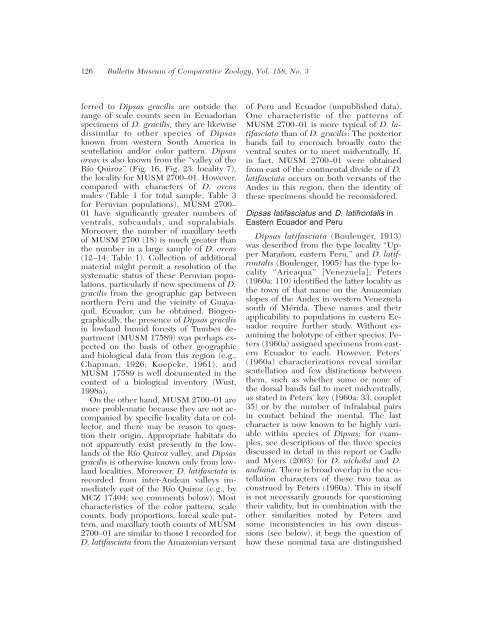systematics of snakes of the dipsas oreas complex - BioOne
systematics of snakes of the dipsas oreas complex - BioOne
systematics of snakes of the dipsas oreas complex - BioOne
You also want an ePaper? Increase the reach of your titles
YUMPU automatically turns print PDFs into web optimized ePapers that Google loves.
126 Bulletin Museum <strong>of</strong> Comparative Zoology, Vol. 158, No. 3<br />
ferred to Dipsas gracilis are outside <strong>the</strong><br />
range <strong>of</strong> scale counts seen in Ecuadorian<br />
specimens <strong>of</strong> D. gracilis, <strong>the</strong>y are likewise<br />
dissimilar to o<strong>the</strong>r species <strong>of</strong> Dipsas<br />
known from western South America in<br />
scutellation and/or color pattern. Dipsas<br />
<strong>oreas</strong> is also known from <strong>the</strong> ‘‘valley <strong>of</strong> <strong>the</strong><br />
Río Quiroz’’ (Fig. 16, Fig. 23: locality 7),<br />
<strong>the</strong> locality for MUSM 2700–01. However,<br />
compared with characters <strong>of</strong> D. <strong>oreas</strong><br />
males (Table 1 for total sample, Table 3<br />
for Peruvian populations), MUSM 2700–<br />
01 have significantly greater numbers <strong>of</strong><br />
ventrals, subcaudals, and supralabials.<br />
Moreover, <strong>the</strong> number <strong>of</strong> maxillary teeth<br />
<strong>of</strong> MUSM 2700 (18) is much greater than<br />
<strong>the</strong> number in a large sample <strong>of</strong> D. <strong>oreas</strong><br />
(12–14; Table 1). Collection <strong>of</strong> additional<br />
material might permit a resolution <strong>of</strong> <strong>the</strong><br />
systematic status <strong>of</strong> <strong>the</strong>se Peruvian populations,<br />
particularly if new specimens <strong>of</strong> D.<br />
gracilis from <strong>the</strong> geographic gap between<br />
nor<strong>the</strong>rn Peru and <strong>the</strong> vicinity <strong>of</strong> Guayaquil,<br />
Ecuador, can be obtained. Biogeographically,<br />
<strong>the</strong> presence <strong>of</strong> Dipsas gracilis<br />
in lowland humid forests <strong>of</strong> Tumbes department<br />
(MUSM 17589) was perhaps expected<br />
on <strong>the</strong> basis <strong>of</strong> o<strong>the</strong>r geographic<br />
and biological data from this region (e.g.,<br />
Chapman, 1926; Koepcke, 1961), and<br />
MUSM 17589 is well documented in <strong>the</strong><br />
context <strong>of</strong> a biological inventory (Wust,<br />
1998a).<br />
On <strong>the</strong> o<strong>the</strong>r hand, MUSM 2700–01 are<br />
more problematic because <strong>the</strong>y are not accompanied<br />
by specific locality data or collector,<br />
and <strong>the</strong>re may be reason to question<br />
<strong>the</strong>ir origin. Appropriate habitats do<br />
not apparently exist presently in <strong>the</strong> lowlands<br />
<strong>of</strong> <strong>the</strong> Río Quiroz valley, and Dipsas<br />
gracilis is o<strong>the</strong>rwise known only from lowland<br />
localities. Moreover, D. latifasciata is<br />
recorded from inter-Andean valleys immediately<br />
east <strong>of</strong> <strong>the</strong> Río Quiroz (e.g., by<br />
MCZ 17404; see comments below). Most<br />
characteristics <strong>of</strong> <strong>the</strong> color pattern, scale<br />
counts, body proportions, loreal scale pattern,<br />
and maxillary tooth counts <strong>of</strong> MUSM<br />
2700–01 are similar to those I recorded for<br />
D. latifasciata from <strong>the</strong> Amazonian versant<br />
<strong>of</strong> Peru and Ecuador (unpublished data).<br />
One characteristic <strong>of</strong> <strong>the</strong> patterns <strong>of</strong><br />
MUSM 2700–01 is more typical <strong>of</strong> D. latifasciata<br />
than <strong>of</strong> D. gracilis: The posterior<br />
bands fail to encroach broadly onto <strong>the</strong><br />
ventral scutes or to meet midventrally. If,<br />
in fact, MUSM 2700–01 were obtained<br />
from east <strong>of</strong> <strong>the</strong> continental divide or if D.<br />
latifasciata occurs on both versants <strong>of</strong> <strong>the</strong><br />
Andes in this region, <strong>the</strong>n <strong>the</strong> identity <strong>of</strong><br />
<strong>the</strong>se specimens should be reconsidered.<br />
Dipsas latifasciatus and D. latifrontalis in<br />
Eastern Ecuador and Peru<br />
Dipsas latifasciata (Boulenger, 1913)<br />
was described from <strong>the</strong> type locality ‘‘Upper<br />
Marañon, eastern Peru,’’ and D. latifrontalis<br />
(Boulenger, 1905) has <strong>the</strong> type locality<br />
‘‘Aricaqua’’ [Venezuela]; Peters<br />
(1960a: 110) identified <strong>the</strong> latter locality as<br />
<strong>the</strong> town <strong>of</strong> that name on <strong>the</strong> Amazonian<br />
slopes <strong>of</strong> <strong>the</strong> Andes in western Venezuela<br />
south <strong>of</strong> Mérida. These names and <strong>the</strong>ir<br />
applicability to populations in eastern Ecuador<br />
require fur<strong>the</strong>r study. Without examining<br />
<strong>the</strong> holotype <strong>of</strong> ei<strong>the</strong>r species, Peters<br />
(1960a) assigned specimens from eastern<br />
Ecuador to each. However, Peters’<br />
(1960a) characterizations reveal similar<br />
scutellation and few distinctions between<br />
<strong>the</strong>m, such as whe<strong>the</strong>r some or none <strong>of</strong><br />
<strong>the</strong> dorsal bands fail to meet midventrally,<br />
as stated in Peters’ key (1960a: 33, couplet<br />
35) or by <strong>the</strong> number <strong>of</strong> infralabial pairs<br />
in contact behind <strong>the</strong> mental. The last<br />
character is now known to be highly variable<br />
within species <strong>of</strong> Dipsas; for examples,<br />
see descriptions <strong>of</strong> <strong>the</strong> three species<br />
discussed in detail in this report or Cadle<br />
and Myers (2003) for D. nicholsi and D.<br />
andiana. There is broad overlap in <strong>the</strong> scutellation<br />
characters <strong>of</strong> <strong>the</strong>se two taxa as<br />
construed by Peters (1960a). This in itself<br />
is not necessarily grounds for questioning<br />
<strong>the</strong>ir validity, but in combination with <strong>the</strong><br />
o<strong>the</strong>r similarities noted by Peters and<br />
some inconsistencies in his own discussions<br />
(see below), it begs <strong>the</strong> question <strong>of</strong><br />
how <strong>the</strong>se nominal taxa are distinguished







